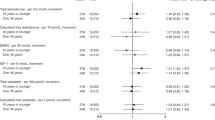Abstract
The aim of this study was to determine whether endogenous estradiol levels in postmenopausal women helped determine the estrogen receptor status of subsequent breast cancers. Within the Guernsey Cohort study of 6127 women, 140 have been diagnosed with breast cancer of whom 59 had estradiol assays performed and ER status available. Estradiol levels in serum and urine were measured by radioimmunoassay and ER status of tumours by immunohistochemistry. Of the individuals in the highest tertile of serum estradiol 35% had ER+ve tumours compared with 27% in the lowest tertile. In terms of 16hydroxyestrone excretion the proportions ER+ve tumours were 22% in the lowest tertile and 38% in the highest tertile. This suggests that endogenous estrogen levels do impact on the phenotype of subsequent breast cancer.
Similar content being viewed by others
References
Bulbrook RD, Hayward JL, Spicer CC, et al. (1962) Abnormal excretion of urinary steroids by women with early breast cancerLancet ii:1238–1240
Thomas HV, Key T, Allen DS, et al. (1997) A prospective study of endogenous serum hormone concentrations and breast cancer risk in postmenopausal women on the island of GuernseyBr J Cancer 76:901–905
Collaborative Group on Hormonal Factors in Breast Cancer. (1997) Breast cancer and hormone replacement therapy: collaborative reanalysis of data from 51 epidemiological studies of 52,705 women with breast cancer and 108,411 women without breast cancerLancet 350:1047–1059
Jones C, Ingram D, Mattes E, et al. (1994) The effect of hormone replacement therapy on prognostic indices in women with breast cancerMed J Aus 161:106–110
Magnusson C, Holmberg L, Norden T, et al. (1996) Prognostic characteristics in breast cancers after hormone replacement therapyBreast Cancer Res Treat 38: 325–334
Li CI, Daling JR, Malone KE. (2003) Incidence of invasive breast cancer by hormone receptor status from 1992 to 1998J Clin Oncol 21:28–34
Gruvberger S, Ringner M, Chen Y, et al. (2001) Estrogen receptor status in breast cancer is associated with remarkably different gene expression patternsCancer Res 61:5979–5984
Fentiman IS, Wang DY, Allen DS, et al. (1994) Bone density of normal women in relation to endogenous and exogenous oestrogensBr J Rheumatol 33:808–815
Key TJA, Wang DY, Brown JB, et al. (1996) A prospective study of urinary oestrogen excretion and breast cancer riskBr J Cancer 73:1615–1619
Thomas HV, Key TJ, Allen DS, et al. (1997) A prospective study of endogenous serum hormone concentrations and breast cancer risk on the Island of GuernseyBr J Cancer. 76: 401–405
Al Saati T, Clamens S, Cohen-Kanafo E, et al. (1993) Production of monoclonal antibodies to human oestrogen receptor protein (ER) using recombinant ER (RER)Int J Cancer 55:651–65
Miyoshi Y, Tanji Y, Taguchi T, et al. (2003) Association of serum estrone levels with estrogen receptor-positive breast cancer risk in postmenopausal Japanese womenClin Cancer Res 9: 2229–2233
Zeleniuch-Jacquotte A, Toniolo P, Levitz M, et al. (1995) Endogenous estrogens and risk of breast cancer: a prospective study in postmenopausal women. Cancer Epidemiol Biomarkes Prev 4:857–860
Nomura Y, Tashiro H, Hamada Y, et al. (1987) Relationship between estrogen receptors and risk factors of breast cancer in Japanese pre- and postmenopausal patientsBreast Cancer Res Treat 4:37–43
Giuffrida D, Lupo L, La Porta GA, Padova G, Foti E, Marchese V. (1992) Relation between steroid receptor status and body weight in breast cancer patientsEur J Cancer 28:112–115
Harlan LC, Coates RJ, Block G, et al. (1993) Estrogen receptor status and dietary intakes in breast cancer patientsEpidemio 4: 25–31
Kushi LH, Potter JD, Bostick RM, Drinkard CR, Sellers TA, et al. (1995) Dietary fat and risk of breast cancer according to hormone receptor statusEpidemiol Biomarkers Prev 4:11–19
Mannisto S, Pietinen P, Pyy M, et al. (1996) Body-size indicators and risk of breast cancer according to menopausal and estrogen receptor statusInt J Cancer 27:8–13
Enger SM, Ross RK, Paganini-Hill A, et al. (2000) Body size, physical activity, and breast cancer hormone receptor status: results from 2 case-control studiesCancer Epidemiol Biomarkers Prev 9:681–687
Hildreth NG, Kelsey JL, Eisenfeld AJ, et al. (1983) Differences in breast cancer risk factors according to the estrogen receptor level of the tumorJ Natl Cancer Inst 70:1037–1031
Stanford JL, Szklo M, Boring CC, et al. (1987) A case-control study of breast cancer stratified by estrogen receptor statusAm J Epidemiol 125:184–194
Li CI, Malone KE, Daling JR. (2002) Differences in breast cancer hormone receptor status and histology by race and histology by race and ethnicity among women 50 years of age and olderCancer Epidemiol Biomarkers Prev 11:601–607
Yoo KV, Tajima K, Miura S, Yoshida M, Kuroishi T, et al. (1993) A hospital-based case-control study of breast cancer risk factors by estrogen and progesterone receptor statusCancer Causes Control 4:39–44
Gapstur SM, Potter JD, Drinkard C, Folsom AR. (1995) Cancer Epidemiol Biomarkers Prev 4:313–318
Potter JD, Cerhan JR, Sellers TA, McGovern PG, Drinkard C, et al. (1995) Progesterone and estrogen receptors and mammary neoplasia in the Women’s Health Study: how many kinds of breast cancer are there?Cancer Epidemiol Biomarkers Prev 4:319–326
Tutera AM, Sellers TA, Potter JD, Drinkard CR, Wiesner GL, Folsom AR. (1996) Association between family history of cancer and breast cancer defined by estrogen and progesterone receptor statusGenet Epidemiol 13: 207–221
Enger SM, Ross RK, Paganini-Hill A, et al. (1999) Alcohol consumption and breast cancer oestrogen and progesterone receptor statusBr J Cancer 78:1308–1314
Althuiss MD, Fergenbaum JH, Garcia-Closas M, et al. (2004) Etiology of hormone receptor-defined breast cancer: a systematic review of the literatureCancer Epidemiol Biomarkers Prev 13:1558–1568
Author information
Authors and Affiliations
Corresponding author
Rights and permissions
About this article
Cite this article
Fentiman, I., Hanby, A., Allen, D. et al. Hormone dependency of breast tumours developing in the Guernsey Cohort Study. Breast Cancer Res Treat 97, 205–208 (2006). https://doi.org/10.1007/s10549-005-9113-8
Received:
Accepted:
Published:
Issue Date:
DOI: https://doi.org/10.1007/s10549-005-9113-8




